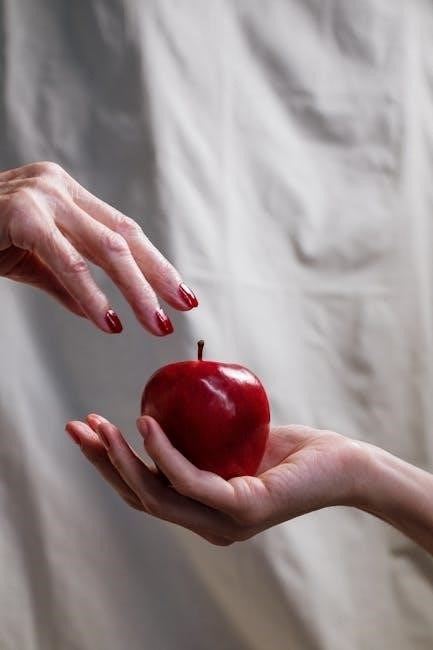Justine and The Story of O, adapted by Guido Crepax, is a 2000 erotic graphic novel published by Evergreen, blending de Sade’s Justine and Aury’s The Story of O․ Crepax’s distinctive art style transforms the novels into a visual exploration of sensuality and submission, featuring sleek, expressive female characters․ This adult comic is celebrated for its artistic refinement and remains a sought-after collector’s item․
1․1 Overview of the Comic Series
Justine and The Story of O is a graphic novel adaptation by Guido Crepax, published in 2000 by Evergreen․ It combines two classic erotic novels, Justine by Marquis de Sade and The Story of O by Dominique Aury, into a visually striking comic series․ The series explores themes of submission, sensuality, and power dynamics, blending intricate storytelling with Crepax’s signature artistic style․ Designed for adult audiences, it falls under the genres of graphic novel, comic art, and erotica, making it a unique and provocative work in the comic medium․
1․2 Guido Crepax and His Artistic Style
Guido Crepax, an Italian comics artist, is renowned for his distinctive style, blending elegance with sensuality․ His work on Justine and The Story of O features sleek lines, minimalistic compositions, and elongated female forms with expressive faces․ Crepax’s art often emphasizes high contrast and subtle expressions, creating a sophisticated visual language․ His style, influenced by European erotic literature, has become iconic in the genre, making his adaptations of these novels a landmark in erotic comic art․
1․3 Historical Context of the Adaptations
Guido Crepax’s adaptations of Justine and The Story of O were published in 2000 by Evergreen, aligning with a late 20th-century resurgence of interest in erotic literature․ The comics reflect a cultural shift toward more explicit content in art and storytelling․ Crepax’s work stands as a bridge between traditional European eroticism and modern graphic narratives, capturing the essence of de Sade and Aury’s original texts while introducing them to a new audience in a visually striking format․

Literary Origins of Justine and The Story of O
Justine, by Marquis de Sade, and The Story of O, by Dominique Aury, are classic erotic novels exploring themes of sensuality and subjugation, inspiring Crepax’s adaptations․
2․1 Justine by Marquis de Sade
Justine, written by Marquis de Sade in 1791, is a provocative novel exploring themes of virtue, vice, and exploitation․ It follows the relentless misfortunes of Justine, a morally upright woman navigating a corrupt society․ The novel delves into philosophical debates on morality and desire, often through explicit and controversial scenarios․ Its exploration of female subjugation and societal hypocrisy laid the groundwork for Guido Crepax’s graphic adaptation, blending eroticism with philosophical inquiry․
2․2 The Story of O by Dominique Aury
The Story of O, written by Dominique Aury under the pseudonym Pauline Réage, is a 1954 erotic novel exploring themes of submission, desire, and empowerment․ The story follows O, a young woman who willingly enters a world of BDSM and sexual submission․ Aury’s work challenges traditional notions of female agency, blending psychological depth with explicit eroticism․ Its controversial themes and lyrical prose have made it a landmark in erotic literature, influencing adaptations like Guido Crepax’s graphic interpretation․

2․3 Themes of Eroticism and Subjugation
Justine and The Story of O delve into themes of eroticism and subjugation, exploring power dynamics and female exploitation․ Both narratives depict women navigating restrictive societies, with Justine enduring misfortune and O embracing submission․ These stories blend explicit eroticism with psychological complexity, challenging societal norms and sparking controversy․ Their exploration of BDSM and sensuality has made them landmarks in erotic literature, influencing adaptations and shaping modern perceptions of sexuality and power․
Guido Crepax’s Adaptation
Guido Crepax’s adaptation of Justine and The Story of O is a 2000 erotic graphic novel published by Evergreen, blending de Sade’s and Aury’s works with his distinctive artistic style․
3․1 Artistic Interpretation of the Novels
Guido Crepax’s adaptation of Justine and The Story of O transforms the novels into a visual masterpiece, blending eroticism with artistic elegance․ His unique style, characterized by intricate line work and composition, reimagines the narratives with a focus on sensuality and psychological depth․ The female characters, depicted with elongated forms and expressive features, embody both vulnerability and strength․ Crepax’s interpretation maintains the original themes of submission and empowerment while infusing them with a modern, sophisticated aesthetic․

3․2 Visual Representation of Erotic Themes
Guido Crepax’s adaptation masterfully visualizes erotic themes through a sophisticated blend of sensuality and artistry․ His intricate line work and composition emphasize the emotional and physical aspects of the narratives․ The characters’ elongated forms and expressive features enhance the eroticism, while subtle symbolism adds depth․ Crepax’s style balances explicit content with aesthetic refinement, creating a visually striking representation of the novels’ themes of desire, submission, and empowerment, appealing to both comic enthusiasts and art connoisseurs․

3․3 Stylistic Choices and Character Design
Guido Crepax’s adaptation is renowned for its distinctive stylistic choices, particularly in character design․ His female characters are depicted with elongated forms, high cheekbones, and expressive, pouting features, creating a striking visual identity․ The art emphasizes sensuality through intricate line work and composition, blending elegance with explicit content․ Crepax’s design choices enhance the narrative’s erotic and psychological depth, making his interpretation of Justine and The Story of O visually captivating and artistically memorable․

Publication and Reception
Justine and The Story of O was published in 2000 by Evergreen and Taschen, becoming a collector’s item․ Its erotic themes and artistic style sparked both acclaim and controversy, solidifying its place in the adult comic genre․
4․1 Publication Details and Editions
Justine and The Story of O was published in 2000 by Evergreen and Taschen․ The hardcover edition features 440 pages, with an ISBN of 3-8228-6302-5․ It is considered a collector’s item, with first editions highly sought after․ The book is in fine condition with a dust jacket, and some copies are described as “Like New” with minimal wear․ It remains a rare and valuable addition to collections of erotic graphic novels․
4․2 Critical Reception and Controversies
Justine and The Story of O received mixed reviews, praised for its artistic style and storytelling but criticized for explicit content․ Critics noted its sophisticated portrayal of erotic themes, while some deemed it controversial due to its graphic nature․ Collectors and enthusiasts celebrated its artistic value, though a few buyers expressed disappointment over missing supplementary materials in certain editions, highlighting the fine line between art and explicit content in this iconic work․
4․3 Impact on Erotic Comic Genre
Justine and The Story of O significantly influenced the erotic comic genre, setting a new standard for artistic and narrative sophistication․ Crepax’s work inspired creators to explore complex themes of sensuality and power dynamics, blending high art with explicit content․ Its success paved the way for more refined erotic comics, establishing it as a landmark in the genre and a collector’s treasure, while sparking debates about the boundaries of art and explicit material in graphic storytelling․

Themes and Symbolism
Justine and The Story of O explores themes of female subjugation, exploitation, and psychological depth, delving into BDSM and eroticism through symbolic visuals and narrative complexity․
5․1 Female Subjugation and Exploitation

Justine and The Story of O vividly portrays female subjugation, with Justine enduring relentless misfortune and O embracing willing submission․ Crepax’s visuals emphasize power dynamics, depicting women in vulnerable yet complex roles․ The narratives explore exploitation within rigid societal structures, blending psychological depth with erotic themes․ These stories provoke reflection on gender roles and control, making them poignant commentary on female experiences in restrictive worlds․
5․2 Exploration of BDSM and Eroticism
Justine and The Story of O delves into BDSM and eroticism, exploring themes of submission, dominance, and sensual experiences․ Crepax’s adaptation visualizes the initiation of characters into worlds of mistresses and masters, blending explicit content with artistic refinement․ The comic balances erotic imagery with psychological depth, making it a significant work in the genre․ Its portrayal of BDSM highlights power dynamics and desire, offering a provocative yet nuanced exploration of human sexuality and control․
5․3 Psychological Depth of Characters
Justine and The Story of O offers profound psychological exploration of its characters, delving into their emotional and mental states; Justine’s resilience amidst suffering and O’s voluntary submission reveal complex inner worlds․ Crepax’s art captures subtle expressions, conveying the characters’ internal struggles and desires․ The narrative probes themes of identity, power dynamics, and personal transformation, adding depth to the erotic themes․ This psychological richness enhances the storytelling, making the characters more than just subjects of sensuality․
Cultural and Historical Significance
Justine and The Story of O holds significant cultural value as a bridge between European erotic literature and visual art․ Crepax’s work influenced modern erotic comics, cementing its historical importance as a collector’s item and a landmark in the genre’s evolution․
6․1 Influence of European Erotic Literature
Justine and The Story of O draws heavily from European erotic literature, adapting works by Marquis de Sade and Dominique Aury․ Crepax’s graphic novel bridges these literary classics with visual art, preserving their themes of sensuality and power dynamics․ The adaptation highlights the transition of erotic narratives from text to graphic form, influencing modern comic art․ This fusion of literature and illustration underscores the cultural significance of Crepax’s work in the evolution of erotic storytelling․
6․2 Role in Shaping Modern Erotic Comics
Guido Crepax’s Justine and The Story of O significantly influenced modern erotic comics by blending literary classics with visual art․ His work set a standard for sophisticated storytelling in the genre, balancing explicit content with artistic elegance․ Crepax’s innovative style and narrative techniques inspired later creators, establishing a benchmark for erotic graphic novels․ The comic’s success paved the way for more nuanced explorations of sensuality and power dynamics, cementing its legacy in the evolution of adult comics․
6․3 Legacy of Guido Crepax’s Work
Guido Crepax’s Justine and The Story of O is celebrated as a landmark in erotic art, blending literary depth with visual sophistication․ His work has become a collector’s item, cherished for its elegance and refinement․ Crepax’s unique style, characterized by sleek lines and expressive character designs, has influenced countless artists and solidified his place in the history of adult comics․ His legacy endures as a masterful fusion of storytelling and sensuality, inspiring future generations of creators in the genre․

The Artistic Style of Guido Crepax
Guido Crepax’s work in Justine and The Story of O is renowned for its refined elegance and sophistication․ His use of sleek lines, high cheekbones, and languid poses creates a visually stunning narrative, blending sensuality with artistic mastery․ Crepax’s style is both intricate and expressive, capturing the essence of the characters while maintaining a timeless aesthetic appeal․
7․1 Use of Line Work and Composition
Guido Crepax’s mastery of line work and composition in Justine and The Story of O is exceptional․ His use of sleek, fluid lines creates a sense of elegance and sophistication, while intricate geometric patterns add depth․ The compositions are meticulously structured, balancing detail with simplicity to guide the viewer’s eye․ This approach enhances the narrative’s emotional impact, blending visual storytelling with erotic themes seamlessly․ Crepax’s line work is both expressive and precise, defining the characters’ forms and the atmosphere of each scene․
7․2 Character Design and Expressions
Guido Crepax’s character designs in Justine and The Story of O are striking, featuring slim, languid women with high cheekbones and pouting expressions․ These designs emphasize sensuality and vulnerability, aligning with the themes of submission and empowerment․ Facial expressions are nuanced, conveying complex emotions that enhance the narrative’s psychological depth․ The characters’ poses and body language further underscore the exploration of eroticism and power dynamics, making them central to the comic’s visual and storytelling impact․
7․3 Integration of Text and Image
Guido Crepax masterfully integrates text and image in Justine and The Story of O, creating a seamless narrative flow․ The placement of text complements the visuals, enhancing the emotional and erotic tension․ Crepax’s use of white space and panel composition ensures that the dialogue and captions are integral to the storytelling, never overwhelming the artwork․ This balance heightens the psychological depth and sensuality, making the comic a compelling fusion of literature and visual art․
The Comic’s Structure and Narrative
Guido Crepax’s adaptation masterfully transforms the novels into a visual narrative, maintaining the original stories’ flow while enhancing the erotic and psychological depth through structured panel compositions․
8․1 Storytelling Techniques in Justine
Guido Crepax’s adaptation of Justine employs a structured, visually driven narrative, blending de Sade’s original text with intricate panel compositions․ The comic maintains the novel’s themes of virtue and misfortune, using sequential art to emphasize psychological depth․ Crepax’s use of line work and expressive character designs enhances the storytelling, creating a balance between eroticism and the exploration of Justine’s enduring spirit․ This approach ensures the comic remains faithful to the source while offering a fresh, visually compelling interpretation․
8․2 Narrative Flow in The Story of O
Guido Crepax’s adaptation of The Story of O masterfully captures the novel’s themes of submission and transformation through a fluid, visually oriented narrative․ The comic follows O’s journey into a world of BDSM, using sequential art to convey her psychological and emotional evolution․ Crepax’s meticulous panel layouts and imagery emphasize O’s willing surrender, creating a seamless flow that balances eroticism with storytelling depth․ This approach ensures the comic remains faithful to Dominique Aury’s original text while enhancing its visual and emotional impact․
8․3 Balancing Eroticism with Storytelling
Guido Crepax’s adaptation of Justine and The Story of O skillfully balances explicit eroticism with narrative depth, ensuring the stories remain engaging and artistically compelling․ By integrating intricate imagery with textual context, Crepax maintains a fluid progression of events while emphasizing the psychological and emotional journeys of the characters․ This balance allows the comic to serve both as an erotic visual experience and a thought-provoking exploration of themes, appealing to readers seeking both artistic and literary merit․
The Role of Women in the Comic
Women in Justine and The Story of O are portrayed as both victims of exploitation and figures of empowerment, their strength emerging through endurance and transformation․
9․1 Portrayal of Female Characters
In Justine and The Story of O, Guido Crepax depicts female characters with striking elegance, emphasizing their sensuality and emotional depth․ His art often features slim, languid women with high cheekbones and expressive faces, embodying both vulnerability and strength․ The portrayal oscillates between submission and empowerment, reflecting the complex themes of the original novels․ Crepax’s female characters are central to the narrative, driving the exploration of eroticism and psychological complexity․
- Physical appearance: Sleek, elongated forms with dramatic expressions․
- Emotional depth: Characters navigate exploitation, desire, and resilience․
- Symbolism: Women embody both objectification and hidden power․
Crepax’s portrayal challenges traditional notions of femininity, blending sensuality with psychological nuance․
9․2 Themes of Submission and Empowerment
Justine and The Story of O explores themes of submission and empowerment through its female protagonists․ Justine’s resilience amidst exploitation contrasts with O’s voluntary surrender, highlighting complex power dynamics․ Crepax’s art emphasizes these dualities, blending vulnerability with subtle strength․ The narratives challenge traditional notions of female agency, presenting submission as both a form of control and a path to self-discovery․ This duality underscores the psychological depth of the characters, making their journeys both provocative and thought-provoking․
- Submission as a form of empowerment․
- Contrasting narratives of Justine and O․
- Exploration of female agency and control․
9․3 Psychological Complexity of Female Leads
Justine and The Story of O delves into the psychological complexity of its female protagonists, exploring their internal struggles and transformations․ Justine’s unwavering virtue contrasts with O’s embrace of submission, revealing layers of emotional depth․ Crepax’s portrayal captures their resilience, desire, and self-discovery, offering a nuanced exploration of female psychology․ The narratives challenge simplistic interpretations, presenting multidimensional characters whose experiences resonate deeply with themes of empowerment and identity․
- Contrasting psychological journeys of Justine and O․
- Exploration of resilience and self-discovery․
- Nuanced portrayal of female emotional depth․

The Comic’s Place in Erotic Art
Justine and The Story of O holds a significant position in erotic art, blending sensuality with narrative depth․ Published by Evergreen in 2000, it showcases Crepax’s unique style, making it a collector’s item and a landmark in the genre․
10․1 Evolution of Erotic Comics
Justine and The Story of O by Guido Crepax marked a pivotal moment in the evolution of erotic comics, blending literary classics with visual artistry․ Published in 2000 by Evergreen, it set a new standard for the genre, combining sophisticated storytelling with explicit content․ Crepax’s unique style, featuring sleek lines and expressive characters, influenced modern erotic comics, establishing it as a landmark work that continues to inspire creators and captivate audiences with its timeless appeal and artistic innovation․
10․2 Influence of Justine and The Story of O
Justine and The Story of O significantly influenced the erotic comic genre, inspiring creators with its unique blend of literary adaptation and visual artistry․ Published by Evergreen in 2000, it became a benchmark for sophisticated adult comics․ Crepax’s work not only elevated the status of erotic comics but also encouraged other artists to explore similar themes, leaving a lasting legacy in the medium and remaining a collector’s item cherished by enthusiasts of both comics and erotic art․
10․3 Comparisons with Other Erotic Works
Justine and The Story of O stands out among erotic comics for its literary depth and artistic sophistication․ While other works often prioritize explicit content, Crepax’s adaptation balances sensuality with narrative complexity․ His sleek, elegant style contrasts with more graphic or fantastical erotic comics, offering a refined aesthetic․ This approach has made it a benchmark, influencing creators to explore similar blends of storytelling and eroticism, solidifying its place as a classic in the genre․
Collectors’ Editions and Rarity
Justine and The Story of O is highly sought by collectors, with first editions from 2000 being particularly valuable․ Published by Evergreen, it remains a rare, prized item․
11․1 First Editions and Their Value
Justine and The Story of O first editions, published by Evergreen in 2000, are highly sought after by collectors․ The hardcover edition, with ISBN 3-8228-6302-5, is particularly rare․ Copies in near-mint condition, with minimal wear and a intact dust jacket, can fetch premium prices․ Some editions, like the one published by Taplinger, are valued for their pristine condition and artistic significance․ These first editions are considered investments, with prices ranging from $200 to $500, reflecting their cultural and artistic importance․
11․2 Limited Editions and Special Releases
Limited editions of Justine and The Story of O are highly collectible, with special releases often featuring unique cover art or slipcases․ Evergreen and Taschen published exclusive runs, enhancing the comic’s allure for collectors․ These editions, sometimes signed or numbered, are sought after for their rarity and artistic presentation; Special releases include deluxe hardcovers with additional content, making them desirable for both collectors and enthusiasts of Crepax’s work․ Their limited availability increases their value and desirability in the market․
11․3 The Comic as a Collector’s Item
Justine and The Story of O has become a prized collector’s item, especially in its first edition and limited release formats․ Published by Evergreen in 2000, the comic’s value lies in its artistic and historical significance․ Collectors seek mint-condition copies with intact dust jackets, as these retain higher value․ The inclusion of additional materials, like essays, further enhances its collectibility․ As Crepax’s work gains recognition, this comic remains a cornerstone in collections of erotic art and graphic novels, appealing to both enthusiasts and investors․
Justine and The Story of O, adapted by Guido Crepax, stands as a landmark in erotic comics, blending literary depth with artistic brilliance․ Its exploration of sensuality and submission, combined with Crepax’s unique style, has cemented its status as a collector’s item and a lasting influence on the genre․
12․1 Summary of Key Points
Justine and The Story of O, adapted by Guido Crepax, is a seminal work in erotic comics, published in 2000 by Evergreen․ It combines Marquis de Sade’s Justine and Dominique Aury’s The Story of O, exploring themes of submission, sensuality, and empowerment․ Crepax’s distinctive art style, featuring sleek lines and expressive characters, elevates the narratives into a visual masterpiece․ The comic has become a collector’s item, praised for its artistic brilliance and its influence on the erotic genre, leaving a lasting legacy in both literature and graphic art․
12․2 Final Thoughts on the Comic’s Significance
Justine and The Story of O, as envisioned by Guido Crepax, stands as a landmark in erotic comics, blending literary depth with artistic brilliance․ Its exploration of submission, empowerment, and sensuality continues to resonate, making it a collector’s treasure․ Crepax’s work not only redefined the genre but also left an indelible mark on the intersection of literature and visual art, ensuring its enduring relevance and admiration among enthusiasts and scholars alike․

